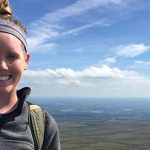
Savannah Stanton is just a junior, but she already has plans to graduate from Oregon State debt free and work to change the world.
“I’ve always wanted to do something for my community and for the world,” she says. “Through renewable materials, I have the opportunity to do that.”
The Newburg High School valedictorian chose to attend Oregon State after she was awarded an academic achievement scholarship, but she still attended classes simultaneously at Portland Community College to get her baccalaureate core classes out of the way and discover her passion. She found it in a class taught by Seri Robinson called “Are You Wearing Mold?”
“The class drew me into the world of renewable materials,” Stanton says. “In the class, we dove into the world of fungi and what could be done with it. It was fun to do a hands-on class like that. It really appealed to me.”
Stanton believes an interdisciplinary course of study will be the key to her future success. He focus within renewable materials is science and engineering. She’s taken business classes, math classes and she will also earn a minor in Spanish.
“Every time a new term starts, I get new ideas,” she says. “My business classes inspired me to think about owning my own business someday instead of working for someone else.”
But Stanton isn’t exactly sure what she wants to do yet. Instead, she’s excited about a world of possibilities at home in Oregon and around the world.
During the summer of 2016, Stanton interned at a wood mill in Chile.
“That was my first time working in a mill setting,” she says. “It helped me understand the traditional part of our industry as well as an idea of the current needs are and expanded who I know within the small world of renewable materials.”
Stanton says her entire experience in Chile was funded through scholarships from the College of Forestry.
Back at home, Stanton is also involved in the student chapter of the Society of American Foresters at Oregon State. SAF is a professional organization dedicated to education and scientific pursuit in the field of natural resources.
“I got involved in SAF because I think it’s important to know what other parts of the industry are up to and what their concern are for the future,” Stanton says. “If you’re able to understand what other components need to make the whole machine work, you won’t get bogged down as much.”
She says that as a new professional, she expects to depend on the timber industry for the renewable materials needed to produce wood products.
“Renewable materials has a lot to do with timber production at some point,” she says. “Right now renewable materials only make up about five percent of the market, but I think it’s important to keep that in mind as I work toward establishing my career.”



